

A Backstage Visit to NBC Radio City
San Francisco in the 1950s
Part 2
By Fred Krock
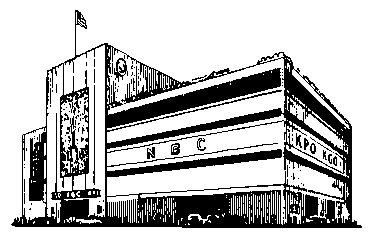
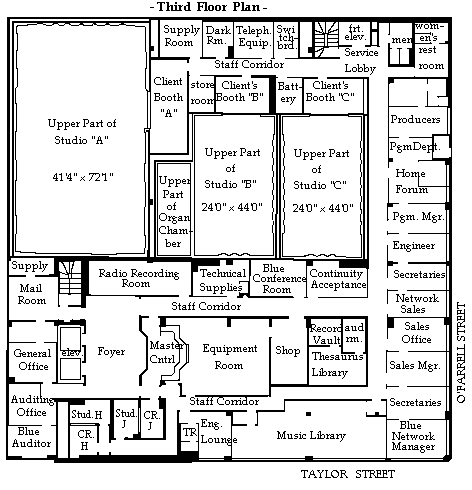
Master Control
 When visitors got off an elevator into the third-floor foyer, master control was visible straight ahead through plate glass windows. Studios H and J were visible through windows on the right. The recording room was visible on the left.
When visitors got off an elevator into the third-floor foyer, master control was visible straight ahead through plate glass windows. Studios H and J were visible through windows on the right. The recording room was visible on the left.
Master control was the switching center of Radio City. It was the hub of the operation. In the early 1950s, it fed KNBC, KNBC-FM, KGO, KGO-FM, and could feed the two radio networks, NBC and ABC. Every audio line in and out of the building went through master control. It also had a Morse code circuit to communicate with engineers at the KNBC Belmont transmitter.
In most radio stations, the mixing consoles were self-contained devices – all amplifiers needed for operation were inside the console, or in an adjoining equipment rack. But this was not the case in Radio City.
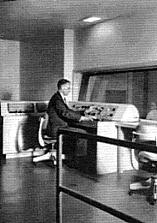 Almost all the amplifiers used in the building were located in an equipment room behind master control on the third floor. Mixing consoles in individual control rooms were nothing but passive mixers. This required a lot of wire, one million feet according to NBC.
Almost all the amplifiers used in the building were located in an equipment room behind master control on the third floor. Mixing consoles in individual control rooms were nothing but passive mixers. This required a lot of wire, one million feet according to NBC.
For example, a microphone in a studio was connected to an amplifier in the equipment room. The signal was amplified and then sent to the mixing console in the control room for that studio. There it was mixed with other sounds and sent back to the equipment room where it was amplified and sent back to the control room again to go through a master gain control. Then it went back to the equipment room to be amplified one final time. Another circuit connected a VU (volume) meter in the console with the final amplifier in the equipment room.
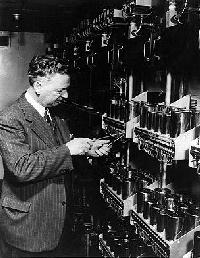 Signals went through patch panels in master control and in the control room at every step in the process. If an amplifier failed, a spare could be patched into the circuit very quickly.
Signals went through patch panels in master control and in the control room at every step in the process. If an amplifier failed, a spare could be patched into the circuit very quickly.
Broadcast equipment in the building had not been installed by NBC engineers. It was wired under contract by a crew of IBEW electricians.
Power for all the amplifiers came from very large power supplies with storage batteries floating on their outputs. This provided an early day UPS (Uninterruptable Power Supply). I heard several different estimates of how long the batteries by themselves could power the equipment. Probably they were good for several days.
One of the souvenirs in the shop was what was left of a screwdriver which accidentally had shorted out one of the battery banks.
The NBC Chime Machines
Master control also had the main and backup chime machines. All the studios had sets of chimes which could be played manually with a mallet in an emergency, but most of the time those familiar NBC trademark chimes came from a machine.
Chime machines were developed so that the duration and volume of the chimes would be constant. NBC had problems with volume levels as different announcers played chimes on or off microphone and in different tempos. The chimes were a system cue telling affiliate stations that the network feed had ended. They had to be loud, clear, and precisely on time.
Chime machines went into service on NBC starting in 1930. The chime sounds were generated by a mechanism similar to a music box. An electric motor turned a revolving drum with properly spaced pins striking against a series of metal reeds tuned to the chime pitches. These vibrations were detected magnetically and amplified to create the familiar three-note NBC chimes.
The chime machine usually operated automatically. Two seconds before the program was scheduled to end, the chime machine would interrupt whatever was coming from a studio and connect directly to the network or to the transmitter. KNBC used the chimes as a trademark at the end of a number of local programs which were not fed to the network.
Sets of manual NBC chimes are available on the collector’s market today. NBC would give souvenir chimes to sponsors or other VIPs as favors or as Christmas presents, thus the large supply.
The Announcer’s Delight
An unusual feature of the NBC operation nation-wide was that the announcers, not the engineers, had jurisdiction over all program switching. At most radio stations, an announcer would give a cue to the engineer who would throw a switch and turn up a fader. This was not the way it was done at NBC. Consoles had no switching capability.
Announcers controlled switching with a device called the Announcer’s Delight. There was one in every studio. In large studios, like Studios A, B, and C, they were in cabinets on wheels so they could be located where convenient, depending on the studio setup.
The front panel of an Announcer’s Delight contained indicator lights, push buttons, and switches to control program routing. Relays which actually did the switching were located in master control. When Radio City, opened the announcer could:
-
Turn microphones on and off or use a microphone to talk to the control room.
-
Turn transcriptions on and off.
-
Join or drop either the Red or the Blue Network.*
-
Turn a remote line on or off.
-
Feed the program to either KGO or KPO.*
-
Feed the program to either the Red or Blue Network.*
-
Monitor either radio station or either network.*
-
Trigger the chime machine.*
-
Enable or disable automatic operation of the chime machine.*
-
Select what was monitored in the studio.
-
Adjust headphone and studio monitor speaker volume.
(* – These functions were restricted to only one station or network after KGO and the Blue Network were sold in 1943. This prevented playing the NBC chimes on the Blue Network, or feeding the wrong network to KPO or KGO by mistake.)
The Announcer’s Delight also allowed an announcer to disable automatic chime operation and to trigger chimes manually for programs with soft end times like live sports broadcasts.
This switching flexibility led to the notorious incident when two announcers simultaneously fed the wrong tag to the wrong station. A speech by the Pope was on KPO. “Al Pearce and His Gang” was on KGO. Both programs ended at the same time. The Pope’s speech was tagged with, “Join us again tomorrow for more fun and nonsense from Al Pearce and his Gang.” Al Pearce’s show was tagged with, “You have just heard an address by His Holiness, Pope Pius.” This story was told by John Grover, long time NBC announcer and collector of bloopers.
(CURATOR’S NOTE: This tale is also told with a slight variation by Glenhall Taylor.)
Engineers were happy to let announcers have switching jurisdiction. Contracts with sponsors called for large financial penalties for errors. Typically, if a program were joined more than nineteen seconds late, the sponsor got the air time free for the whole program. A five-second error called for something like a fifty percent discount on the air time. Engineers were perfectly happy not to share the blame when mistakes occurred.
Usually, engineers opened faders before a switch occurred. The only usual exception was when an announcer pushed the transcription button. The engineers faded up records and transcriptions as they started. On rare occasions, when a network program was joined in progress, the engineer would fade up under a live local voice-over.
(In Chicago, the home of the musicians’ union, musicians had jurisdiction over playing recorded music at the NBC-owned station. Two men were in the control room, a musician and an engineer. The musician played recorded music on a separate set of turntables. The engineer adjusted volume levels, played transcriptions, and did everything else.)
Problems with Turntables
Seventy-eight RPM phonograph records played on KNBC had a characteristic sound. When the record first started, the speed went slightly above 78 RPM, then settled down to the correct speed. This caused a very subtle change of pitch. The RCA turntables used by KNBC were responsible.
RCA turntables were gear-driven. The platter which revolved was fairly heavy, about ten to fifteen pounds, to provide stability. Soft rubber blocks provided isolation between the turntable shaft and the gear box.
The engineer would start the turntable revolving before he received the cue to start playing a record. He would hold the record stationary while the turntable revolved underneath, to keep it from playing until he received his cue. This technique was called “slip starting.” The friction of the stationary record on top of the revolving turntable would compress the rubber isolation blocks. When the record was released to start playing, energy stored in the compressed rubber blocks caused the turntable to over-speed slightly. This effect was heard only on 78 RPM phonograph records. Thirty-three and one-third RPM transcriptions were not affected.
Older-model RCA turntables had another delightful feature. The lever which selected speed, either 33 1/3 or 78 RPM, was located underneath the record. If an engineer started playing a record or transcription at the wrong speed, he had to turn off the turntable, move the pickup aside, remove the record, change the speed, put the record back on the turntable, put the pickup back on the record, and restart the turntable. This took as long as it sounds. Did I personally ever get caught by an RCA turntable? Why do you think I remember this?
RCA’s first turntable was even worse. It required sticking a special tool into a slot under the record to change speed. Later models of RCA turntables had the speed control on the rim of the platter so speed could be changed without having to remove anything.
The front of an RCA turntable cabinet opened. Frequently engineers would store things inside. Unlike most turntables which had the motor at the top, RCA turntables had the motor, gearbox, and several universal joints at the bottom of the cabinet.
One KGO engineer, who happened to be the president of the union local, would work on various handicraft projects in the control room while he was riding the network or playing long transcribed programs. He stored his craft supplies under a turntable until one evening while a transcription was playing some supplies got caught in the mechanism bringing the program to an abrupt halt. This led to a company memo which ended the practice of using turntable cabinets as storage lockers.
The Recording Room
On the left side of the third-floor foyer was the recording room, which originally contained six disc-recording lathes. By the 1950s, most of the lathes had been replaced by tape recorders, used to tape-delay programs for future broadcast. Lathes still were used for recording commercials.
Transcribed announcements had begun to arrive from advertising agencies on pre-recorded tapes rather than on transcription discs. Cart machines had not been invented yet. The spots were dubbed onto 16-inch transcription discs for play on the air.
All disc recording had been concentrated in one room for several reasons. An engineer could not mix a program and run a recording lathe at the same time. Invariably, the lathe needed attention at the same instant some part of the program required undivided attention from the engineer. One engineer, however, could oversee several recording lathes at the same time.
Instantaneous recording discs were made from aluminum coated with cellulose nitrate lacquer. They were called acetates in the business. This was a misnomer because they were coated with nitrate, rather than acetate plastic. Actually, the coating was a regular witches brew of lacquer, plasticizers, dyes, lubricants, and much more.
They were called instantaneous recordings because they could be played immediately after recording. Wax masters, which had been used earlier, could not be played until they were processed and a record was pressed.
Cutting records threw off a thread of plastic which was called the chip. This stuff was dangerously explosive if you touched a match to it. Guncotton is cellulose nitrate. The chip was sucked into a tube connected to a vacuum pump. Then the chip automatically was dumped into a tank of water for safety as it was collected.
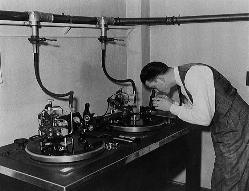 Two 16-inch discs were needed to record a half-hour program. Sound quality deteriorated when the recording got close to the inside. To prevent the sound quality from changing noticeably when segueing from one disc to another, the first fifteen minutes would be recorded cutting from the outside of the disc to the inside. The second half-hour would be recorded starting at the inside going out.
Two 16-inch discs were needed to record a half-hour program. Sound quality deteriorated when the recording got close to the inside. To prevent the sound quality from changing noticeably when segueing from one disc to another, the first fifteen minutes would be recorded cutting from the outside of the disc to the inside. The second half-hour would be recorded starting at the inside going out.
The segue was made from inside cut to inside cut, so the sound quality did not change. Another advantage of this technique was that the best sound quality of the transcription, at the outside of the disc, was heard next to live announcer voices at the beginning and end of the show.
At fourteen minutes into the program, the engineer would start cutting silence on the second disc. When all was well and the chip was collecting properly, the engineer would turn on the sound and at the same time spiral the first recording to create a visible track one minute long. The playback engineer had one minute to synchronize the two discs and then crossfade. This technique was needed only when music played continuously through the crossfade time. Usually, the engineer would listen to the beginning of the second disc, note a good crossfade point, like the end of a sentence, cue to that point, and make a regular slip-start of the second disc.
During World War II aluminum was needed for war production more than it was needed for recording blanks. Very thin glass was used as a substitute base for recording discs. These discs were called “glassies.” They were extremely fragile. A hard look was almost enough to break one. You could break a glassie by bumping it too hard on the center spindle when putting it on a turntable.
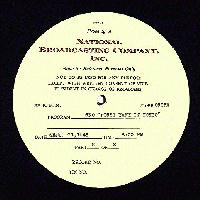 The recording room was very busy during the war. Everything broadcast by KPO was recorded for review by government censors. KPO could be heard clearly at night all over the eastern half of the North Pacific Ocean. The government wanted to be sure that no spies were sending secret messages to the enemy. Weather reports and forecasts were prohibited.
The recording room was very busy during the war. Everything broadcast by KPO was recorded for review by government censors. KPO could be heard clearly at night all over the eastern half of the North Pacific Ocean. The government wanted to be sure that no spies were sending secret messages to the enemy. Weather reports and forecasts were prohibited.
Since everything was recorded and all network programs were live, some spectacular bloopers were preserved. Whenever they caught something particularly good, the engineers would dub a copy for John Grover who collected bloopers.
One from Grover’s collection had a moral about watching where you put a page break in a script. The Superman program was wrapping up. The cast rarely rehearsed these programs. Actors were expected to be able to perform reading the script cold. Once again, Superman had vanquished evil. Reporter Clark Kent had scored a great success with his story. He was being congratulated by editor Perry White with these words: “Well, Clark, what do you want me to do? Kiss your (pause to turn page) foot?” The entire cast broke up. They laughed their way up to the closing commercial without finishing the script. The announcer couldn’t make it through the closing commercial. A different voice didn’t have much better luck with the Blue Network system cue.
Studios H, J and K
Windows on the right side of the third-floor foyer allowed visitors to see into Studio H and Studio J. The letter I was not used, to prevent confusion with the numeral 1 in the documentation. Each studio had its own control room. These two studios were used for routine station breaks and for recorded music programs. A typical program on KNBC would be “The Burgie Music Box.” On KGO it would be “Lucky Lager Dance Time.”
Studio J, closer to Master Control, was used by KNBC. Studio H was used by KGO. By the 1950s almost all local program content on both stations originated here. Very few programs originated in the second-floor studios.
After KGO moved out in 1954, Studio H occasionally was used for separate programs on KNBC-FM. At different times, NBC briefly tried a classical music format and an all-news format on KNBC-FM.
Programs from Studio J had an unusual sound for many years. Turning on the microphone caused a slight click on the air. Perhaps the Announcer’s Delight was so close to the microphone that transients from control wiring were picked up by a transformer in the microphone. RCA ribbon microphones had a transformer inside. Or perhaps some other cross-talk was in the wiring.
After KGO was sold, it used the old newsroom on the second floor. A new newsroom for NBC was on the fourth floor about where the program department office had been. A small studio and control room were built next to the newsroom, probably after the war ended. This was Studio K. The control room had a stock RCA console. It was the only control room which did not use amplifiers in the equipment room on the third floor. KNBC broadcast several fifteen-minute newscasts and a farm report every day. They originated in Studio K.
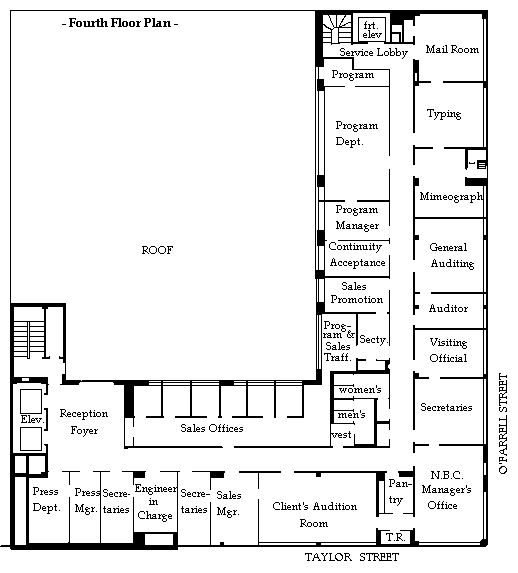
The Engineers’ Schedule
Master Control had two engineers assigned twenty-four hours a day. Even when KNBC was off the air between 2 and 5 AM, they might be busy reversing the network for a news feed from the Pacific Rim or the West Coast for use in an early morning newscast on the East Coast. NBC service to the east began at 3 AM Pacific Time.
The second engineer was used to provide relief breaks for the first master control engineer and occasionally for other engineers. The union contract called for two breaks and a lunch hour each day for studio engineers. Breaks and the lunch hour were sacrosanct.
RCA Victor Records used the NBC network line to record the San Francisco Symphony when it was not being used for broadcasts. The orchestra played in the Opera House starting at midnight. A line installed for “Standard Hour” broadcasts took the sound to Radio City. It was fed on the NBC network line to Hollywood where the record masters were cut in the RCA recording studio. At that time NBC still used 8 kHz telephone circuits for the network.
Some programs for the West Coast originated at KNBC until the NBC Pacific Network closed in 1952. Most were designed to provide network service to the Pacific Time Zone on Sunday afternoons starting at 4 PM when East Coast primetime programs began. I remember some truly awful drama shows.
Sound Effects
The engineers union, NABET, had jurisdiction over sound effects at NBC. This made a certain amount of sense because many sounds came from phonograph records. Variable speed turntables on the sound effects cart had two tonearms. This allowed producing a continuous sound, such as an automobile running, from a single record. While one tonearm was playing, the other could be moved back to the beginning of the cut. Turntable speed could be changed to simulate the car slowing or speeding up. NBC had two sound effect carts at Radio City.
All programs used the same Major, Valentino, or Standard sound effect records. Technically, they sounded pretty bad. A lot of recorded sounds originally came from the movies. You could hear the same recorded sound effects on all four radio networks.
Many other sounds were made manually. An inflated balloon full of poppy seeds could make the sound of surf or of rain falling. Crinkling cellophane made the sounds of a crackling fire. The sound of breaking glass was made by dropping small, thin steel plates on the floor. The sound effects cart had a lot of miniature doors with various types of latches and locks. Many other sounds, for example filling a glass with liquid, were made by the real thing.
Sound effects men were allowed to use their voices to produce sounds without having to belong to the announcer’s union as long as they did not say words. One KNBC engineer, a very dignified middle-aged man wearing a bow tie, could imitate perfectly the sound of a crying baby.
Microphone Wars
NBC had a rule that all equipment used by the network must be made by RCA. The KNBC transmitter in Belmont had been converted from a General Electric to an RCA by repainting it and installing an RCA nameplate to comply.
This all-RCA equipment rule led to an interesting squabble with a major sponsor, the Standard Oil Company of California (known today as Chevron). For many years, Standard had sponsored “The Standard Hour,” a live one-hour program of concert music every Sunday evening at eight featuring performances by outstanding West Coast orchestras, such as the San Francisco Symphony and the Los Angeles Philharmonic. It was broadcast on the NBC Pacific network throughout the area where Standard products were sold. Standard also sponsored other programs on NBC and KNBC.
 About 1950, Altec introduced the 21-series condenser microphones. These were the first modern small-diaphragm condenser microphones. They produced a vast improvement in sound quality over the RCA ribbon microphones used by NBC. The “Standard Hour” producers wanted to use Altec microphones for their broadcasts. NBC said no way, we use only RCA microphones.
About 1950, Altec introduced the 21-series condenser microphones. These were the first modern small-diaphragm condenser microphones. They produced a vast improvement in sound quality over the RCA ribbon microphones used by NBC. The “Standard Hour” producers wanted to use Altec microphones for their broadcasts. NBC said no way, we use only RCA microphones.
Standard threatened to take its entire advertising budget, rumored to be two-million dollars a year, from NBC and go to CBS where good microphones were appreciated. NBC officials then decided that they could make an exception to the all-RCA equipment rule for their good friends at Standard. That was how “The Standard Hour” got to use Altec microphones.
Listeners of old-time radio programs occasionally would hear comedians making fun of the network censors. KNBC had its own censor, euphemistically called “Continuity Acceptance Department.” As an example of the local censor in action, Jimmy Lyons in the 1950s had a late-night program of jazz records which originated at the Club Hangover in San Francisco. (Lyons later went on to found the Monterey Jazz Festival.) “Hangover” was a dirty word to the local censor. As a result, the program was always identified on the air as originating at the Club Hannover.
The Dress Code
NBC had a dress code for employees at Radio City. All men wore conservative business suits, white shirts, and neckties. A few men wore bow ties. Men were allowed to remove their jackets and work in shirt sleeves. Transmitter operators could wear slacks and shirts without neckties.
Women wore suits or skirt and sweater combinations. They were not allowed to wear slacks. Short skirts, revealing necklines, gaudy jewelry, or garish colors were frowned upon.
Old-time announcers said that, until about 1938, NBC required them to wear tuxedos at all times when working, even when they were not visible to the public.
At one time, NBC required announcers to have college degrees. Any old degree would do. This led to a large variety of disciplines being represented. Announcer Bud Heyde was a music major. He planned to make a career as a theater organist. By the time he graduated from college, talking pictures had replaced most theater organists, so Heyde became a radio announcer instead.
A lot of gray hair was seen at KNBC. In part, this was because network-owned stations were at the top of the food chain in broadcasting. Employees had to work their way up through the business to get hired. New hires were older than at most stations. Pay was good. Very few staff members left.
San Francisco was the end of the line for many broadcast careers in those days. The only career step up was to Hollywood or New York. Who would want to work in those shark-infested waters or live in either city?
Engineers had no incentive to leave. They worked under a nation-wide union contract. Engineers at KNBC were paid exactly the same salary as at WNBC in New York.
At the beginning of 1950 NABET union scale for a Group 2 engineer at NBC was $121.38 per week. Basic studio and transmitter engineers were classified as Group 2. Group 6 working supervisors earned $144.23 per week. These were very good wages at the time.
A minimum wage job paid $20 per week. Most office secretarial or clerical jobs paid $30 to $40 per week. Blue-collar jobs typically paid from $60 to $80 per week. An announcer who worked at KSFO remembers being paid $89 per week AFTRA scale at about this same time.
Announcers at KNBC were paid the highest staff announcer union scale in San Francisco. In addition, they got board fees. Every time they read a commercial, they received a talent fee. Network feeds also brought extra pay. They were happy to remain at KNBC. Most had been there for a long time.
Announcers at KNBC probably took home about twice what the engineers were paid. Base pay was similar to engineers. Several announcers told me that they made more money from board fees than from base pay. This starts to get into the region of show biz salaries where publicized figures need to be multiplied by a correction factor of .1 to .5 to get the actual number.
To put these salaries into perspective, in 1950 a streetcar fare in San Francisco was ten cents, a fast-food hamburger cost nineteen cents, a new Chevrolet cost around $2,000, and if you wanted to make a statement with your automobile you could drive home in a new Cadillac for about $3,500. Several subdivisions on the San Francisco Peninsula advertised new three-bedroom houses with prices starting well under $20,000.
KNBC saw major staff reductions in all departments starting in the 1950s. Union contracts required layoffs to be in order of inverse seniority. The last hired was the first fired. Although this was not required with non-union employees, the same policy usually was followed. The result was that many employees at Radio City were middle-aged or older.
Today even in major markets many radio station employees are young. The industry eats its young by burning them out. The broadcast industry is very different from the way it was when KGO and KNBC shared Radio City.
Copyright © 1998 by Fred Krock.
Reprinted with permission. All rights reserved.
![]()

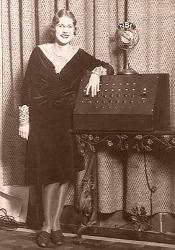
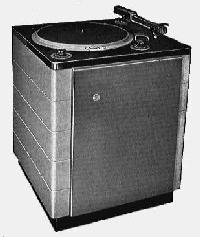
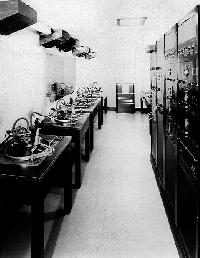
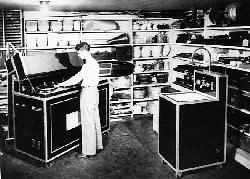
[…] PART 1 | PART 2 […]